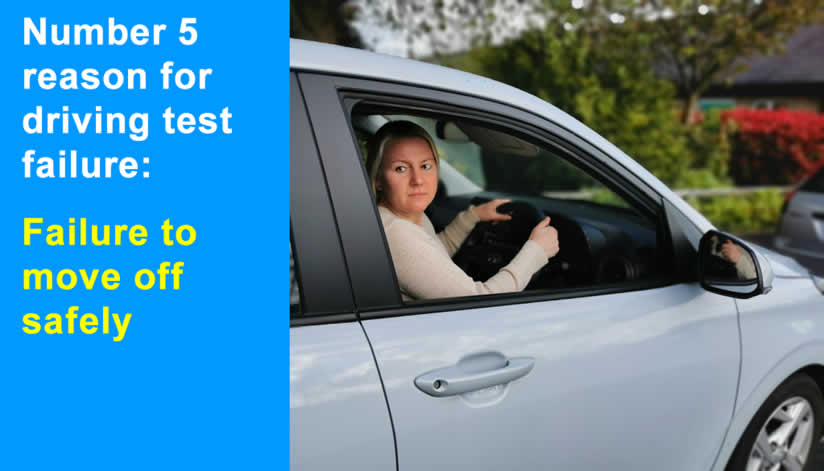During a practical driving test, the examiner will ask the test candidate to pull up on the left (possibly on multiple occasions) and they may also ask the test candidate to pull up on the right to carry out a manoeuvre. Pulling up at the side of the road and moving off can include:
- Moving off from the side of the road
- Moving off on a gradient (hill start)
- Moving off at an angle (from behind a parked car)
- Moving off from the right-side of the road
Faults related to moving off are often always due to lack of observations. Forgetting a simple mirror check or blind spot check is enough to gain a serious fault on the test. A fault that causes another road user to alter their speed or requires the examiner to take control of the vehicle will be recorded as a dangerous fault.
On the test report sheet, if the examiner checks a fault box when moving off, it will come under the ‘Moving off – Safely’ section. We’ll now explain the 5th most common reason to fail a driving test; not moving off safely, along with the the reasons why test candidates fail in this category.
Forgetting to Check Blind Spots
This situation involves the test candidate moving off from the side of the road and not checking the appropriate blind spot prior to moving. Examiners usually request that the test candidates pull up and move off on a few occasions. This is to ensure that they do so safely and under control. Repeatedly failing to check blind spots will result in a test failure.
It’s essential that before moving off from the side of the road, either from the left or right side, you carry out the appropriate mirror checks and blind spot check. If you’re moving off from the left-side of the road, check the right blind spot prior to moving the car and check the left blind spot if you’re moving off from the right-side of the road.
Moving off at an Angle
This is a procedure that requires the test candidate to pull up on the left behind another vehicle. When pulling up, the test candidate should park reasonable close behind the parked vehicle, while ensuring they have enough space in front of their vehicle to move off again.
Because of the parked vehicle in front, it means the test candidate has to move off at an angle, around the parked vehicle. This fault arises after the test candidate has checked the mirrors and blind spot, but moves off into the path of an approaching vehicle. This causes the approaching vehicle to either significantly slow down or stop.
It might not always be easy to see around a parked vehicle before moving off. In this instance, you should move forward very slowly, constantly checking the mirrors and blind spot, while also observing what’s in front of you. Continue to slowly edge forward until you can see that it’s safe to proceed.
Moving off from the Right-side of the Road
Pulling up on the right, reversing for two car lengths and moving off is one of the four manoeuvres that the examiner may ask you to carry out. This fault occurs when the test candidate has completed the manoeuvre and moves off either into the path of an oncoming vehicle or just ahead of a closely following vehicle. This results in the vehicle having to significantly reduce speed.
When you have completed the manoeuvre, the examiner will ask you to move off when ready. This doesn’t mean that it’s safe to move off as it’s down to the test candidate to determine this. Additionally, the pulling up on the right manoeuvre can be carried out on a reasonably busy road, where continuous traffic prevents the test candidate from moving off.
Waiting can be frustrating, especially for long periods and test candidates often fear getting faults for hesitation. But the priority here is to be patient and only move off when you’re absolutely certain that it’s safe to do so. Even if you have missed an opportunity for moving off, it’s better to get a (minor) fault for hesitation than a serious fault and failing the test.
Moving off After an Emergency Stop
Out of every three driving tests that are conducted, one will involve the emergency stop exercise. This fault involve the test candidate completing the emergency stop and securing the vehicle. The examiner then tells the candidate that they can continue when ready, but the candidate fails to make any rear observations prior to moving off.
Before moving off after completing the emergency stop, you must complete an all-round six-point check. Look all round starting with the left blind spot, then into the left side mirror, the internal mirror, out of the front windscreen, right side mirror and right blind spot. It doesn’t matter if you don’t do all the checks in a specific order too much, but the main priority is that you’ve conducted sufficient observations before moving off.
